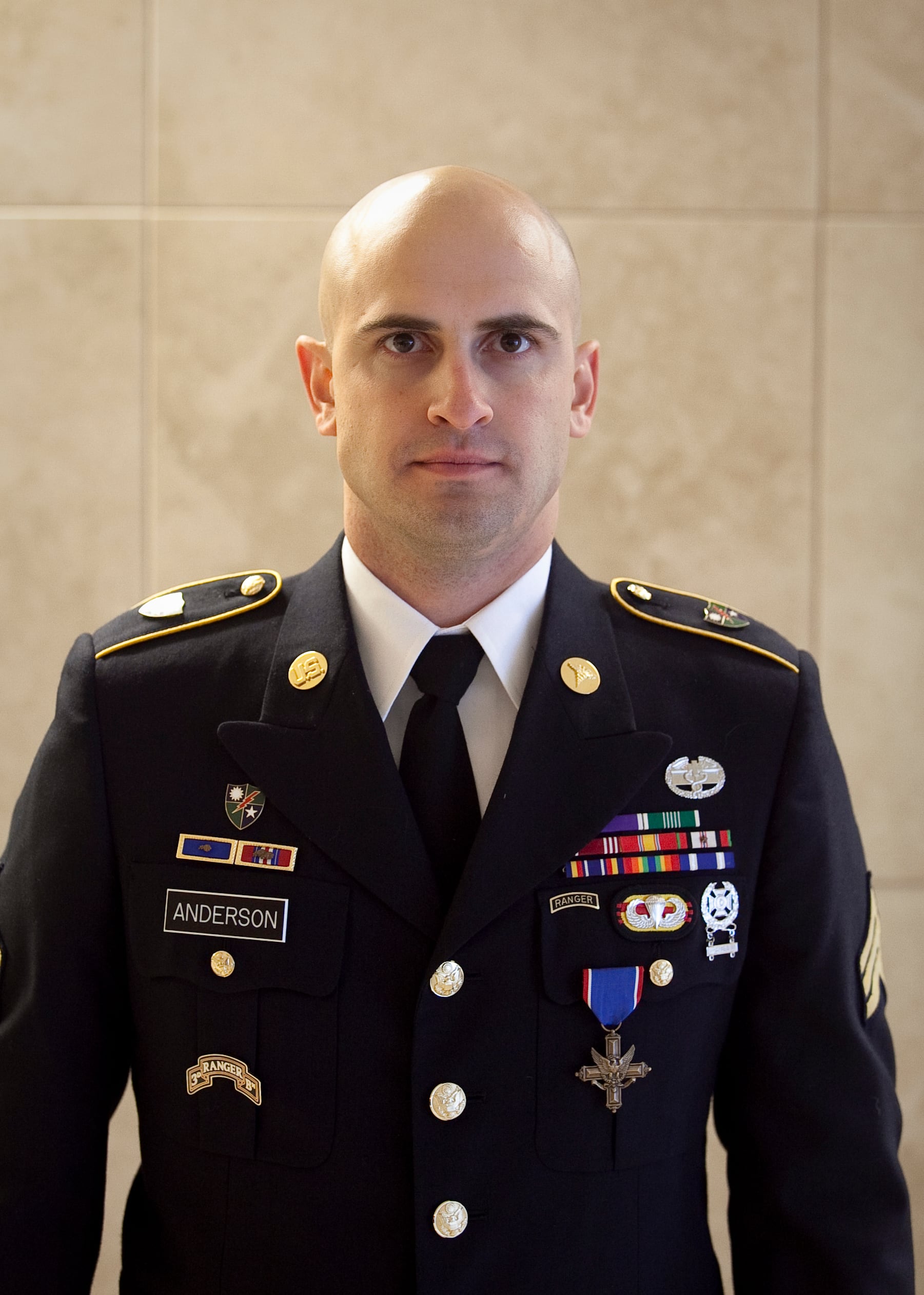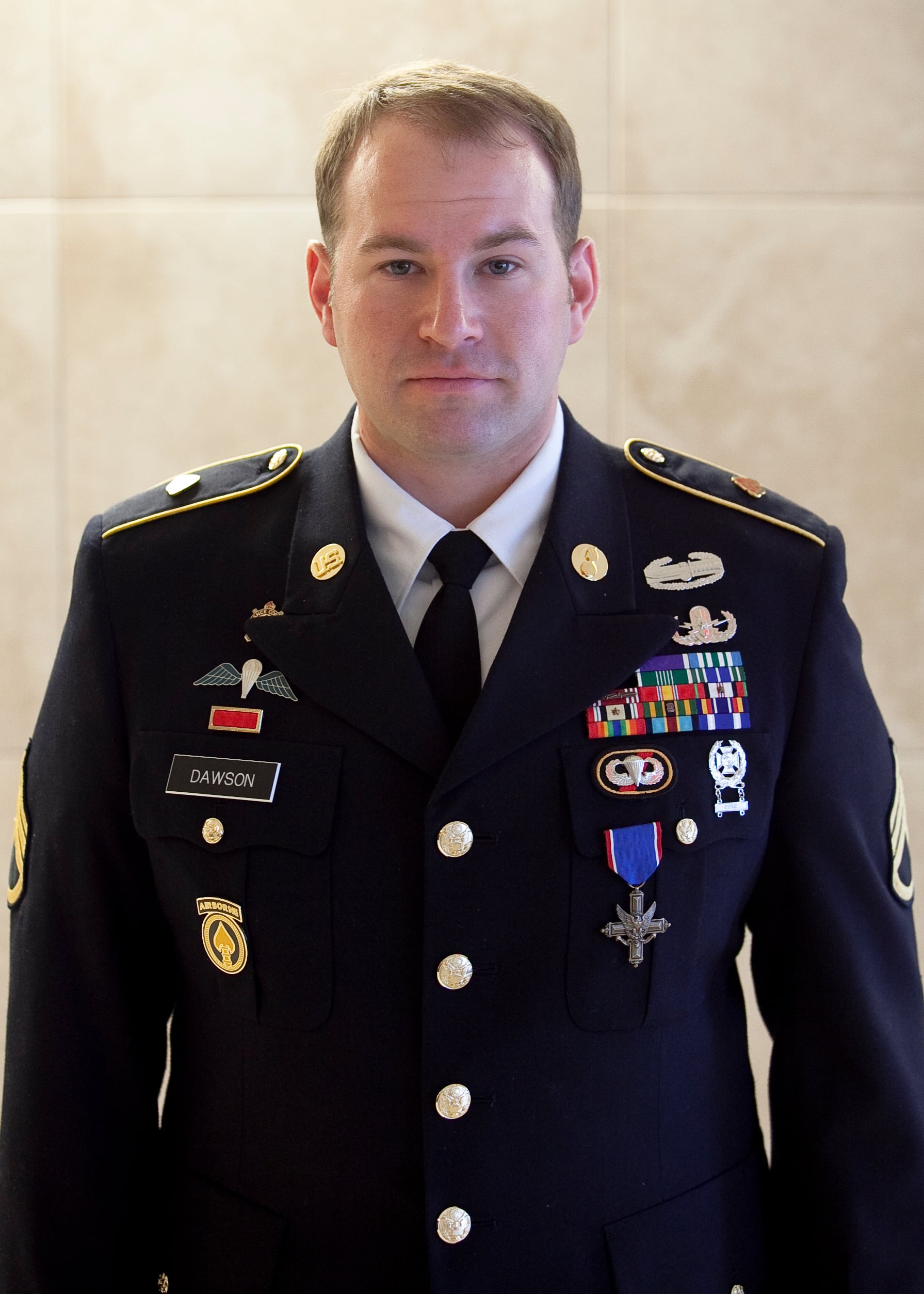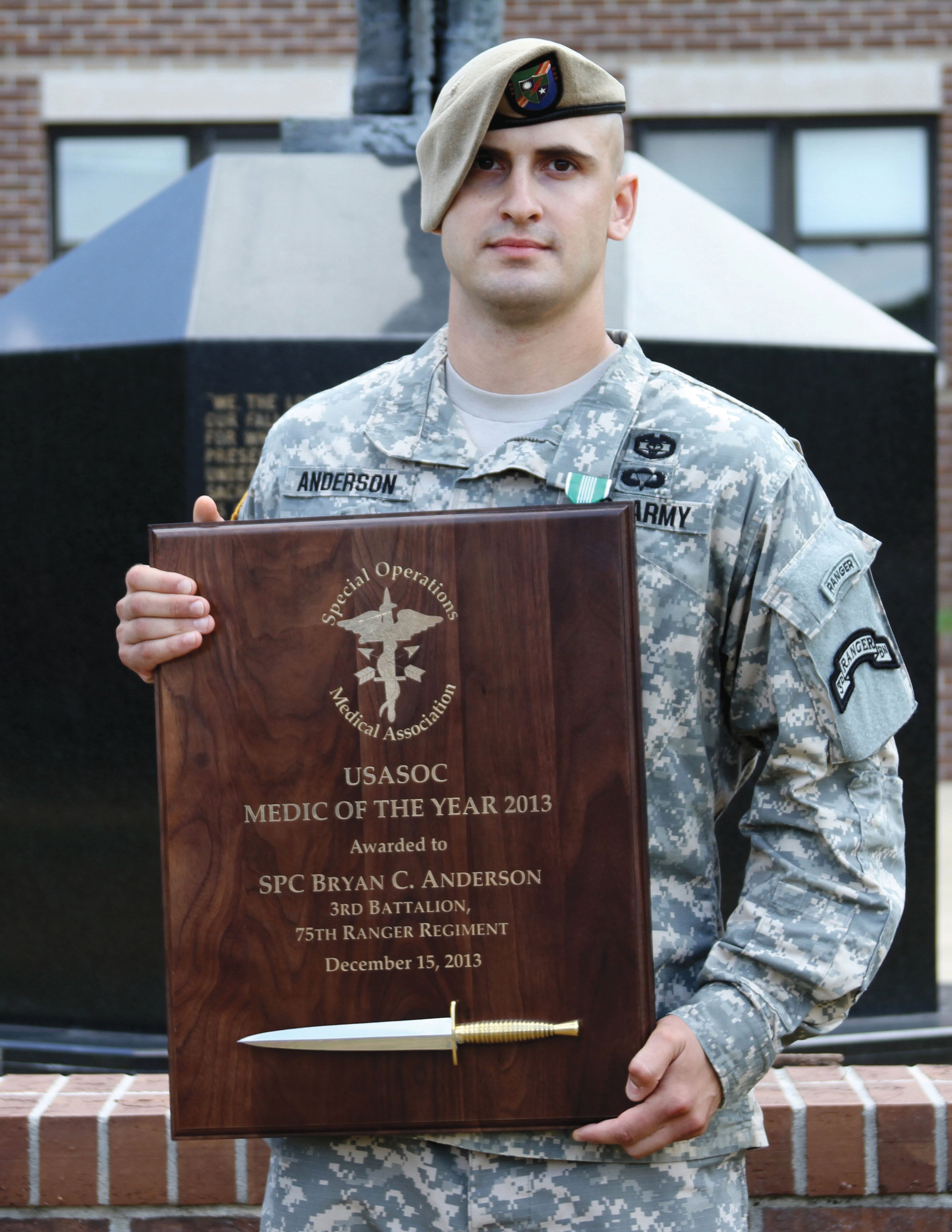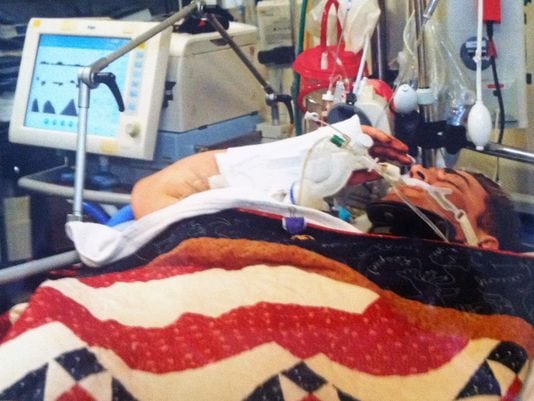Sgt. Bryan Anderson heard the bombs explode. Three deafening booms ringing almost simultaneously.
Without a second thought, he sprinted 300 meters toward the explosions.
"I wasn't concerned with my life," said Anderson, a medic. "I was concerned that I had buddies who were bleeding out back on the compound."
For his actions on that night in southern Afghanistan, Anderson on Tuesday received the Distinguished Service Cross, a valor award second only to the Medal of Honor.

Sgt. Bryan Anderson
Photo Credit: Patrick A. Albright/Army
Also presented with the DSC was Staff Sgt. Jeffery Dawson, an explosive ordnance disposal technician who, despite limited visibility inside a compound heavily seeded with IEDs, relentlessly and repeatedly cleared the way to retrieve his fallen and wounded teammates.
Receiving the DSC is "so surreal," said Dawson, who belongs to the 28th Ordnance Company, an airborne EOD unit at Fort Bragg, North Carolina.
"It's kind of hard to process the whole thing," he said. "It's an honor."
Anderson, who is assigned to 3rd Battalion, 75th Ranger Regiment, at Fort Benning, Georgia, downplayed his actions.
"I'm very humbled … and at the same time almost guilty," he said. "I was just out there doing my job. I think every medic would have done the same thing out there, and I don't think any of us would have asked for recognition for it."

Staff Sgt. Jeffery Dawson
Photo Credit: Patrick A. Albright/Army
The night of Oct. 5, 2013, started out as "any other night," Anderson said — yet another night mission to kill or capture a high-value enemy target in Afghanistan.
But the mission in Kandahar province, which stretched into the early morning hours, would be anything but ordinary, as the team of Rangers assaulted in to find multiple suicide bombers and a deadly belt of buried improvised explosive devices.
Four soldiers were killed. Forty received the Purple Heart.
In addition to the two DSCs awarded Tuesday, one soldier previously received the Silver Star, the third-highest award for valor, for his actions that night. Also honored since, were 11 soldiers who received the Bronze Star with V device, and 18 who were awarded the Army Commendation Medal with V device.
When the team landed near the target compound, Dawson and Anderson split off with a smaller element to chase a fleeing insurgent.
Within seconds, the first of several explosions rang out from the target compound.
At least eight troops were wounded in the initial blasts.
Anderson, 26, ran toward the compound, calling his platoon sergeant on the way.
"There was a lot of traffic coming across the radios, but no one could really determine what was going on yet," said Dawson, 28.
Almost immediately after the blasts, the soldiers chasing the fleeing insurgent released Jani, a military working dog, to go after their target. But the insurgent detonated his suicide vest, killing himself and Jani.
Shrapnel peppered Dawson's legs. Smoke filled the air, making it difficult to see.
Dawson, the EOD tech, decided the team should move back to the compound to rejoin the rest of the assaulters. With no regard for his own injuries, Dawson cleared a safe path for the team to rejoin the rest of the task force, according to the narrative accompanying his award.
At the compound, Anderson quickly moved to the first casualty he saw on the ground. Sgt. Thomas Block had been blown backwards and severely wounded by a suicide bomber.
The senior medic on the ground was already treating Block, so he instructed Anderson, then a specialist and platoon medic, to move to the next patient, Pvt. 1st Class Benjamin Pinnick.
Dawson began to clear a path to Pinnick, who was "directly in the center of the entire IED belt," he said.
"At this point, I knew that there were IEDs everywhere," Dawson said. "I just didn't know where they were at or how they were employed in the ground."
When he got to Pinnick, Anderson was already there, having run past unexploded IEDs to reach the wounded man, according to the narrative accompanying Anderson's award.
"I wasn't concerned with getting hurt myself," Anderson said. "I was concerned about my brothers being hurt."
Pinnick, who is now a specialist, had shrapnel in his left leg and a serious injury to his pelvis.
Anderson put a tourniquet on the soldier's leg, packed the pelvic wound and then treated a shrapnel wound in the soldier's chest.
When the first medevac helicopter landed to load the casualties, dust from the rotor wash spread, and a series of explosions went off. An IED exploded when 1st Lt. Jennifer Moreno, a nurse assigned to a special operations cultural support team, moved to aid a teammate. She was killed instantly.
Sgt. Patrick Hawkins and Spc. Cody Patterson, both of 3rd Battalion, were killed when two more IEDs exploded as they moved toward Anderson and the wounded soldier.
The blasts knocked Anderson over.
"I don't remember being knocked out, but I do remember being a little confused," Anderson said. "I had to look down to make sure I had my legs and arms."
After checking on his patient, Anderson moved over to Hawkins, who had severe trauma to his face and abdomen, and whose left arm and leg had been amputated, according to the narrative accompanying Anderson's award.
"He had taken the brunt of the blast on his left side," Anderson said. "I controlled as much [of the bleeding] as I could."

Last year, then-CPl. Bryan Anderson, 3rd Battalion, 75th Ranger Regiment, was named the 2014 U.S. Army Special Operations Command Medic of the Year.
Photo Credit: Sgt. 1st Class Michael R. Noggle/Army
Hawkins couldn't breathe, so Anderson made an incision to clear his airway, but Hawkins died soon afterward.
At this time, Sgt. Joseph Peters, a special agent with the 5th Military Police Battalion, triggered two IEDs as he returned from helping the wounded at the medevac landing zone.
Anderson rushed to Peters.
Peters' legs had been amputated in the blast, so Anderson put pressure on his legs and worked with another soldier to apply tourniquets on the wounds.
"He was initially conscious, talking to us," Anderson said about Peters.
At the same time, Dawson began clearing a 30-foot lane through the IED-laden area to allow an Air Force pararescueman to reach and provide aid to Peters.
Dawson then cleared his way to Patterson.
"Acting alone and refusing to leave a fallen comrade, Sgt. Dawson recovered Spc. Patterson's remains and returned them to the casualty collection point," according to the narrative accompanying his award.
From the casualty collection point, Dawson began clearing yet another path, this time to Moreno.
After about 25 feet, Dawson found an IED and marked it for the rest of the force to see. He adjusted his route and kept going, eventually finding two more IEDs as he worked his way to Moreno.
Using his metal detector and his hands, Dawson also cleared a path to the helicopter landing zone, knowing the task force would need a way to safely and quickly evacuate the wounded.
"That's when I put the whole schematic of how all the IEDs were laid out," Dawson said. "I stopped and I looked up, and I could see a center line. The IEDs were on both sides of this center wire. All the IEDs were wired in parallel, so you could close each circuit individually without affecting the others."
Dawson said he could see at least six to 10 IEDs from where he was, like "little ant trails to patches of dirt."
As Dawson returned to the casualty collection point, Cpl. Joshua Hargis triggered another explosion as he tried to reach Peters.
The blast took off both Hargis' legs. He also had a fractured pelvis and left hand, as well as shrapnel to his face and arms, Anderson said.

Cpl. Joshua Hargis, a Ranger from Company B, 3rd Battalion, 75th Ranger Regiment, was severely wounded during a direct action raid against an insurgent compound, Oct. 6, 2013, in Kandahar Province, Afghanistan. Just a few hours after extensive surgery, Col. Christopher S. Vanek, Commander of the 75th Ranger Regiment, awarded Hargis the Purple Heart. After receiving the award, Hargis began to move, surprising everyone in the room who thought he was still unconscious. The medical staff tried to restrain his right arm, fearing he would damage his intravenous tubes. Then everyone in the room realized what he was trying to do. He was trying to salute.
Photo Credit: U.S. Army photo by Sgt. Eric J. Glassey
Dawson, who was less than five feet from the blast, suffered a ruptured ear drum and shrapnel wounds to his left side.
"Completely disregarding his own wounds, Sgt. Dawson immediately moved to assist the platoon medic treating Cpl. Hargis," according to the narrative.
"I got to Hargis, and I was looking at his legs, and I remember just reaching down and putting a tourniquet on his left leg while Anderson was applying pressure to his femoral artery," Dawson said.
But the tourniquet broke, so Dawson applied pressure to Hargis' femoral arteries while Anderson applied another tourniquet.
Anderson continued to treat Hargis, giving him pain medication, freeze-dried plasma and other drugs.
"I was working on him for an hour and a half," Anderson said.
Hargis, who had suffered blast lung, needed help breathing.
"It ended up being an hour and 37 minutes until we were off the ground with him," Anderson said.
When the Air Force PJ arrived to help Anderson, Dawson turned his attention to clearing a more direct route to the casualty collection point.
"At this point, realizing the increasing severity of the [pressure plate] IED threat, Sgt. Dawson recommended a strict freeze call … and all additional movement by strike force members ceased," the narrative states.
As the quick-reaction force, which included additional EOD personnel, arrived on the ground, Dawson briefed them on the situation before he was ordered to prepare for medical evacuation.
"I was pretty dazed," Dawson said. "I was about 5 feet away when Hargis hit the plate. I was charged up pretty good. I don't know what was going through my mind, honestly."
Dawson said he remembers feeling fine.
"I didn't really want to go," he said, but the senior noncommissioned officer on the scene forced him onto the next medical evacuation bird.
Dawson, who has since deployed again to Afghanistan, said he simply relied on his training that night.
"When you get into situations like this, you really revert back to your training and what you know, and you kind of just go on autopilot," he said. "You know something needs to be done, you know how to do it, and it's just doing it."
Anderson, who endured seven IED or suicide vest blasts from a distance of no more than 10 meters within a span of 30 minutes, agreed.
"I know this is such a textbook answer, but it's the truth," he said. "I really did completely revert back to my training. We train for these situations all the time so that when it happens, on these one-in-a-million chances, you're prepared to do what you need to do."
The bonds between the Rangers was a key factor as well, Anderson said.
"I never even thought twice about running to one of those patients," he said. "The guys are basically my family, so when one of them is hurt, and I'm their medic, it's my job to go make them better."
Michelle Tan is the editor of Army Times and Air Force Times. She has covered the military for Military Times since 2005, and has embedded with U.S. troops in Iraq, Afghanistan, Kuwait, Haiti, Gabon and the Horn of Africa.




